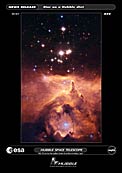Star on a Hubble diet
The star cluster Pismis 24 lies in the core of the large emission nebula NGC 6357 that extends one degree on the sky in the direction of the Scorpius constellation. Part of the nebula is ionised by the youngest (bluest) heavy stars in Pismis 24. The intense ultraviolet radiation from the blazing stars heats the gas surrounding the cluster and creates a bubble in NGC 6357. The presence of these surrounding gas clouds makes probing into the region even harder.
One of the top candidates for the title of "Milky Way stellar heavyweight champion" was, until now, Pismis 24-1, a bright young star that lies in the core of the small open star cluster Pismis 24 (the bright stars in the Hubble image) about 8,000 light-years away from Earth. Pismis 24-1 was thought to have an incredibly large mass of 200 to 300 solar masses. New NASA/ESA Hubble measurements of the star, have, however, resolved Pismis 24-1 into two separate stars, and, in doing so, have "halved" its mass to around 100 solar masses.
Credit:NASA, ESA and Jesús Maíz Apellániz (Instituto de Astrofísica de Andalucía, Spain). Acknowledgement: Davide De Martin (ESA/Hubble)
About the Image
| Id: | heic0619a |
|---|---|
| Type: | Observation |
| Release date: | 11 December 2006, 19:30 |
| Related releases: | heic0619 |
| Size: | 3140 x 5057 px |
About the Object
| Name: | Pismis 24, Pismis 24-1 |
|---|---|
| Type: | Milky Way : Star : Grouping : Cluster |
| Distance: | 8000 light years |
| Constellation: | Scorpius |
| Category: | Nebulae Star Clusters |
Image Formats
Coordinates
| Position (RA): | 17 24 45.29 |
|---|---|
| Position (Dec): | -34° 12' 3.06" |
| Field of view: | 2.62 x 4.22 arcminutes |
| Orientation: | North is 171.7° left of vertical |
Colours & filters
| Band | Wavelength | Telescope |
|---|---|---|
| Optical V | 550 nm |
Hubble Space Telescope
ACS |
| Optical V | 547 nm |
Hubble Space Telescope
WFPC2 |
| Optical H-alpha + Nii | 658 nm |
Hubble Space Telescope
ACS |
| Infrared I | 850 nm |
Hubble Space Telescope
ACS |
| Optical H-alpha | 656 nm |
Hubble Space Telescope
WFPC2 |



